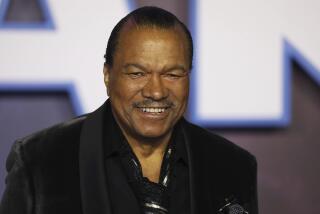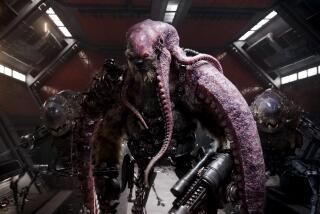The Player: How ‘Star Wars Battlefront’ created the B-side to John Williams’ score
Some of the first sounds you hear in “Star Wars Battlefront” are instantly recognizable. The exuberant brass notes strike a triumphant tone from John Williams’ signature score, welcoming players before any action has begun. Then things start to change.
Much of “Star Wars Battlefront” (the Dice-developed video game, released Tuesday for the PlayStation 4, Xbox One and PCs) boasts an original score from composer Gordy Haab. His mission: to re-create the sound of the original trilogy without out-and-out copying Williams. Throughout the game, 30-or-so second snippets of Williams’ music are inter-spliced with longer, newer works from Haab.
“The request for the sound of ‘Battlefront’ was to sound as though it was the B-side of the original trilogy soundtrack album -- the lost tracks from John Williams that you didn’t get to hear,” Haab said last week. “My goal was to live very much in that world.”
SIGN UP for the free Indie Focus movies newsletter >>
Haab has worked in the “Star Wars” gaming universe before. He has composed scores for “Star Wars: The Old Republic,” a game set thousands of years before the events of the original trilogy, and the more lighthearted “Kinect: Star Wars,” a title that pulls from the era of the prequels.
Haab, then, has become something of a student of “Star Wars,” and, in particular, the sounds of Williams. Haab was asked what makes “Star Wars” sound like “Star Wars.”
“The music of ‘Star Wars’ is defined by a culmination of many factors,” he said. “One of which is the use of the full range of the orchestra, from the highest piccolo notes to the lowest lows, which creates a sense of vast size and space. And of course, brass. From the solo French horn to the full brass section fanfares, and in particular, the heroic use of the trumpet section.”
Haab said there are vast differences between the music of the two trilogies.
“The original trilogy is much more thematic, in the sense that every character has a very short leitmotif that he pulls from constantly,” Haab said. “It kind of jumps around from theme to theme, based on who’s on screen. It’s much more about that concept of the leitmotif and the short melodies. Then there’s the big moments where he opens up these broad melodies.”
The prequels, on the other hand, are more active, said Haab, with music that’s constantly jumping “from one section of the orchestra to the other really quickly.” Though “Battlefront” relies almost exclusively on action -- the game is like a greatest hits collection of “Star Wars” action scenes -- Haab said he wanted a more thematic rather than rhythmic sound for the game.
“I’m of the old-school philosophy of having characters have themes, which is sort of the leitmotif idea that John Williams does so well, particularly in ‘Star Wars,’” Haab said. “It’s almost like an opera in that every character has a theme and every planet has a theme and so on and so on. I approach writing music for other media as the same way. I like to have a theme to work with for each character, or, in the case of ‘Battlefront,’ for each planet.”
Working with the 100-member strong London Symphony Orchestra, Haab was able to construct mini-suites of music for each locale in “Battlefront.” Each main selection created by Haab has something of a two- or three-minute overture, allowing him to then mix in themes throughout the more action-oriented music.
“First, I’d start with an existing 30-second piece from John Williams’ original score to set a familiar tone,” Haab said. “Then transition into something completely new, continue my music for two minutes or so, and then transition back to a different piece from John Williams -- before switching back to my own music, and so on, to create long suites of music to accompany any given planet or faction in the game.”
While his music for battling on the snowy planet of Hoth, for instance, references Williams’ work with “Star Wars: Episode V -- The Empire Strikes Back,” especially in its frenetic nature and alarming use of the trumpet, Haab worked to give his orchestration some atmospheric flourishes. Due to the frenzied nature of the game, however, Haab had to keep the pace brisk.
“I tried to capture the feeling of the icy, stark nature of the planet with a dense harmonic palette, cascading winds and cold metallic sounds, while using sweeping muted strings and large sheets of metal to emulate blizzard-like wind gusts,” Haab said.
The goal was to be recognizable -- just not too recognizable.
“I hope the audience takeaway is they get to feel the familiarity of the original score that they love, but get to hear a new take on it.”
Twitter: @Toddmartens
ALSO:
OK, ‘Fallout 4’ is amazing to explore. But is it really worth all the work?
‘Star Wars Battlefront’ looks and feels like ‘Star Wars.’ Is that enough?
‘Call of Duty: Black Ops 3’ puts a female soldier on the battlefield. What took so long?
More to Read
The biggest entertainment stories
Get our big stories about Hollywood, film, television, music, arts, culture and more right in your inbox as soon as they publish.
You may occasionally receive promotional content from the Los Angeles Times.







